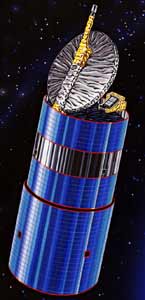Thank you very much for visiting Gunter's Space Page. I hope that this site is useful and informative for you.
If you appreciate the information provided on this site, please consider supporting my work by making a simple and secure donation via PayPal. Please help to run the website and keep everything free of charge. Thank you very much.
APStar 1, 1A / ZX 5D, 5E (ChinaSat 5D, 5E)

APStar 1 [Boeing BSS]
The APSTAR 1 spacecraft carries such general communications traffic as voice, fax, data, and television signals across China and Hong Kong, Indonesia, Japan, Singapore, and Vietnam. APSTAR 1A has expanded coverage to India and Pakistan. Hughes Space and Communications International, Inc., signed a contract in May 1992 with APT Satellite Company, Ltd., of Hong Kong for the first satellite. APT ordered APSTAR IA in March 1995. The spacecraft were built at the Hughes Space and Communications Company facilities in El Segundo, Calif.
APSTAR I and IA are is the latest versions of the popular HS-376 spin-stabilized satellite. They carry 24 active transponders (with six spares), operating in the C-band (6/4 GHz) and extended C-band (3.6 GHz) frequency range, and are powered by 15 watt traveling-wave tube amplifiers. Each of four channels has 72 MHz of bandwidth, and the remaining 20 each have 36 MHz capacity. Radiated power over China averages 35 dBW.
All spacecraft in the HS-376 satellite line have two telescoping cylindrical solar panels and an antenna or antenna array that folds down for launch. APSTAR I and IA measure 2.2 meters in diameter and a compact 3.1 meters tall when stowed for launch. With the solar panels deployed and the antenna unfolded in orbit, they measure 7.5 meters.
The solar panels are covered with K-4 3/4 solar cells, which produce 1130 Watts at beginning of life. During eclipse, two super nickel-cadmium batteries provide power for uninterrupted service. With stationkeeping fuel the satellites weighed about 726 kg at beginning of life on-orbit.
The transmit and receive beams are created by a 2-meter round antenna with two reflecting surfaces. One is sensitive to vertical polarization and the other to horizontal. Separate microwave feed networks are used for the different polarizations.
APSTAR I has an operational life of 9 years. The APSTAR IA contract calls for 10 years of service.
APT contracted for both satellites to be launched aboard the Chinese CZ-3. Hughes provided APT with support services for the missions. The company also trained APT's satellite controllers and built a satellite control facility in the Tai Po region of Hong Kong. The center is similar to 22 other facilities built by Hughes for customers around the world.
APStar 1A was renamed ZX-5D in September 2010 and APStar 1 was renamed ZX-5E in October 2012.
| Nation: | China |
|---|---|
| Type / Application: | Communication |
| Operator: | APT Satellite Company Ltd. |
| Contractors: | Hughes |
| Equipment: | 24 (+6) C-band transponders |
| Configuration: | HS-376 |
| Propulsion: | Star-30CBP |
| Power: | Solar cells (body mounted and drop-skirt), batteries |
| Lifetime: | 9 years (#1); 10 years (#1A) |
| Mass: | 1400 kg (726 kg BOL) |
| Orbit: | GEO |
| Satellite | COSPAR | Date | LS | Launch Vehicle | Remarks | |
|---|---|---|---|---|---|---|
| APStar 1 → ZX 5E | 1994-043A | 21.07.1994 | Xi LC-3 | CZ-3 | ||
| APStar 1A → ZX 5D (ChinaSat 5D) | 1996-039A | 03.07.1996 | Xi LC-3 | CZ-3 |
References:
- Boeing Satellite Systems website
